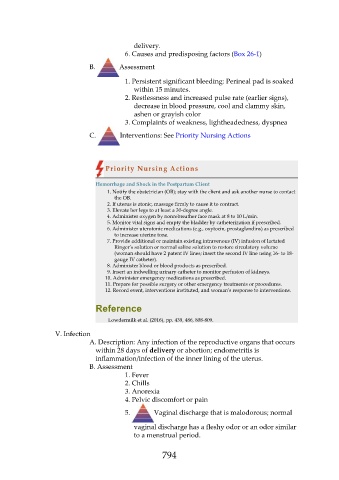Page 794 - Saunders Comprehensive Review For NCLEX-RN
P. 794
delivery.
6. Causes and predisposing factors (Box 26-1)
B. Assessment
1. Persistent significant bleeding: Perineal pad is soaked
within 15 minutes.
2. Restlessness and increased pulse rate (earlier signs),
decrease in blood pressure, cool and clammy skin,
ashen or grayish color
3. Complaints of weakness, lightheadedness, dyspnea
C. Interventions: See Priority Nursing Actions
Priority Nursing Actions
Hemorrhage and Shock in the Postpartum Client
1. Notify the obstetrician (OB); stay with the client and ask another nurse to contact
the OB.
2. If uterus is atonic, massage firmly to cause it to contract.
3. Elevate her legs to at least a 30-degree angle.
4. Administer oxygen by nonrebreather face mask at 8 to 10 L/min.
5. Monitor vital signs and empty the bladder by catheterization if prescribed.
6. Administer uterotonic medications (e.g., oxytocin, prostaglandins) as prescribed
to increase uterine tone.
7. Provide additional or maintain existing intravenous (IV) infusion of lactated
Ringer’s solution or normal saline solution to restore circulatory volume
(woman should have 2 patent IV lines; insert the second IV line using 16- to 18-
gauge IV catheter).
8. Administer blood or blood products as prescribed.
9. Insert an indwelling urinary catheter to monitor perfusion of kidneys.
10. Administer emergency medications as prescribed.
11. Prepare for possible surgery or other emergency treatments or procedures.
12. Record event, interventions instituted, and woman's response to interventions.
Reference
Lowdermilk et al. (2016), pp. 439, 486, 808-809.
V. Infection
A. Description: Any infection of the reproductive organs that occurs
within 28 days of delivery or abortion; endometritis is
inflammation/infection of the inner lining of the uterus.
B. Assessment
1. Fever
2. Chills
3. Anorexia
4. Pelvic discomfort or pain
5. Vaginal discharge that is malodorous; normal
vaginal discharge has a fleshy odor or an odor similar
to a menstrual period.
794

